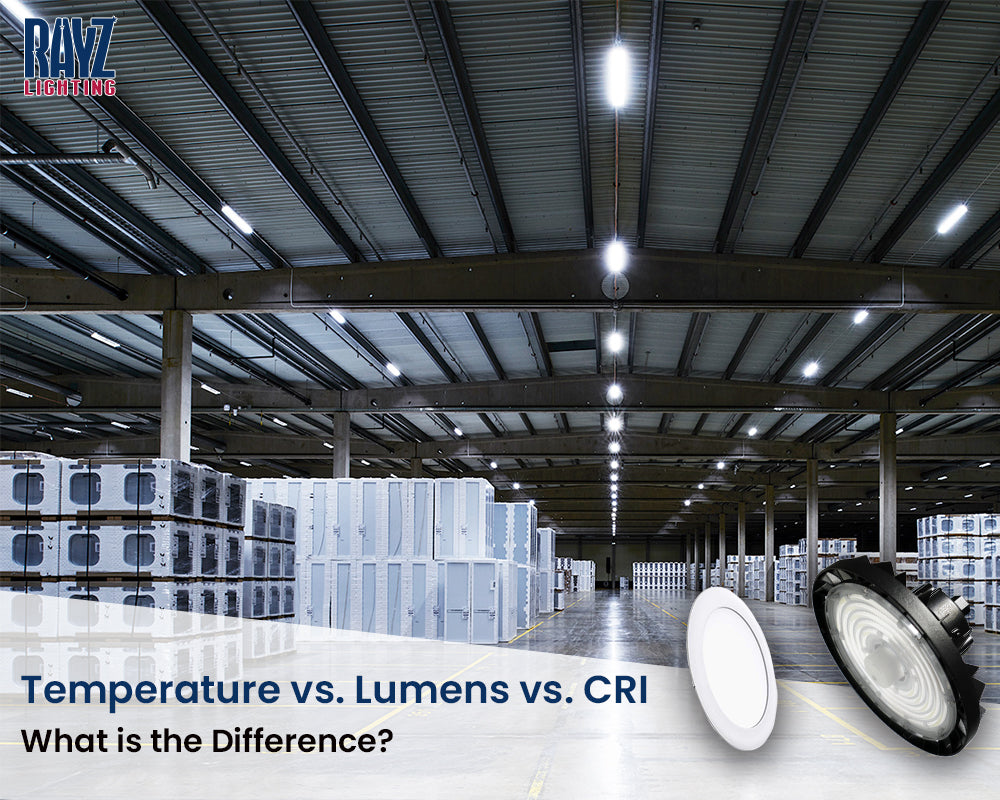Temperature V/S. Lumens V/S. CRI - What's the Difference?
RECENT POSTS
-
 Fri, Mar 17, 23
Fri, Mar 17, 23 -
 Fri, Feb 24, 23
Fri, Feb 24, 23 -
 Thu, Feb 09, 23
Thu, Feb 09, 23 -
 Mon, Jan 30, 23
Mon, Jan 30, 23
TAG CLOUD
- Benefits of Flood Lights
- best led flood light
- commercial ceiling lights
- Commercial Lighting
- FAQ
- high bay lighting solutions
- High Bay Lights Motion Sensor
- How does the Motion Sensor Work?
- Importance of LED
- Indoor Lighting
- Industrial LED Light Fixture
- LED
- led flood light lumens
- LED Football Stadium Light
- LED Gym Lighting
- LED High Bay Lights
- LED Light Connecticut
- LED Light for Food Processing Plant
- LED Lighting
- LED lightings
- LED lights
- LED Street Light Vs. LED Parking Lot Light
- Lumens vs. CRI
- outdoor flood lights
- Outdoor Lights
- Rayz Lighting
- Rebate
- Retail Stores
- Stadium Light
- Temperature vs. Lumens
- UFO High Bay Lighting
- UFO High bay lighting for Warehouse
- Warehouse
- warehouse lighting

Earlier, when LEDs had not made it to the mainstream lighting fixture segment, choosing a light fixture was straight forward. There were limited lighting options with limited specifications in all categories.
However, LEDs have changed the game completely. With numerous lighting options in various categories, it has become challenging for users to pick the right ones.
They often get confused with its core specifications, like CCT, CRI, and Lumens.
Looking at their struggle to find the relevant LEDs, we have decided to unveil the difference between Temperature vs. Lumens vs. CRI to help them make the right decision.
So, here's a complete explanation:
What is CCT?
CCT stands for Correlated Color Temperature - a number measured in degrees Kelvin, used to describe a light source's relative warmth or coolness.
By using this measurement, users find it easy to select lighting fixtures with the desired qualities and match different lights together.
The CCT of an LED light fixture uses a carefully tuned phosphor layer to mimic the spectrum of a more conventional source, such as sunlight.
Nowadays, most light bulbs range from 2700K (warm, incandescent color) to 5000K or higher (crisp, white daylight color). These numbers are rounded to standardized numbers to simplify the system.
For example, LEDs ranging from 2700K to 3000K are the most-preferred lighting option for home and residential applications.
These category lights create a nice, warm appearance that creates a soothing and relaxing environment.
In retail or commercial application areas, 4000K is the most suitable color option as it ensures a bright and more energetic shade of illumination.
For industrial or task-oriented applications, 5000K or more is the best color option, as this range of color temperatures best reflects natural daylight.
CCT's Ecosystem:
Different LEDs comprise different CCT values. Consider overviewing the below list to learn more about the CCT ranges and their color reflections t human eyes:
- 2700K – Soft and Warm White
- 3000K – Bright and Soft White
- 4000K – Pure and Cool White
- 5000K – Daylight, Cool White, Crystal White
The warm CCTs (2700K) produce fewer glares and are less prone to refraction, making them ideal for applications like home.
Natural white CCTs (4000K–4500K) are specifically designed for office and educational settings, retail applications, and industrial area lighting.
It helps people see objects with better clarification and give them a natural angel view.
Cool white CCTs (≥5000K) are ideal for ample outdoor area lighting and industrial projects as they ensure better illumination. It improves workers' visibility and enhances their safety, security, and productivity.
Now that we have covered the primary prospects of the three specifications of a LED let's move the other two - Lumens and CRI!
What are Lumens?
Lumens, in a LED light, measure the total calculated brightness of a light. Lumens also significantly impact other metrics, such as efficacy and Lux.
Efficacy is the brightness (lumens) ratio to power consumption (wattage). This measurement (lm/W) is essential as it is one of the main criteria used to qualify for specific certifications and rebates.
On the other hand, Lux (lumens/square meter) displays how much light will reach a nearby surface.
This measurement depends on the distance from the light source to where the light output is being measured. Lux measurements ensure pathways and heavy work areas are adequately illuminated, enhancing safety and security requirements.
What is CRI?
The acronym of CRI is Color Rendering Index, used to measure the "quality" of a light fixture. The CRI of an LED light fixture is measured by comparing the color appearance of natural sunlight.
Natural sunlight is considered the standard for light quality, rated at 100 CRI - the highest possible rating.
While most standard LEDs have a CRI value of 80, high CRI LEDs have a CRI value of 90 or higher.
Lower CRI light sources alter the reflected color due to an excess or lack of specific color wavelengths, making the reflected colors look different to the eye.
Meanwhile, higher CRI (90-95+) light sources have excellent color rendering ability. These fixtures come very close to mirroring the spectrum of natural sunlight.
Choose a perfect LED Lighting Fixture from Rayz Lighting!
So here we are, wrapping up the most discussed topic, Temperature vs. Lumens vs. CRI in the LED lighting segment. We hope you find it helpful.
If you have any doubts regarding the same and wish to discover more, post your queries in the comment section below. Our officials will come up with the most convenient answers for you.
Meanwhile, you are welcome to take a detour of our inventory to pick the most suitable LED lights with appropriate CCT, Lumens, and CRI for your establishments.












